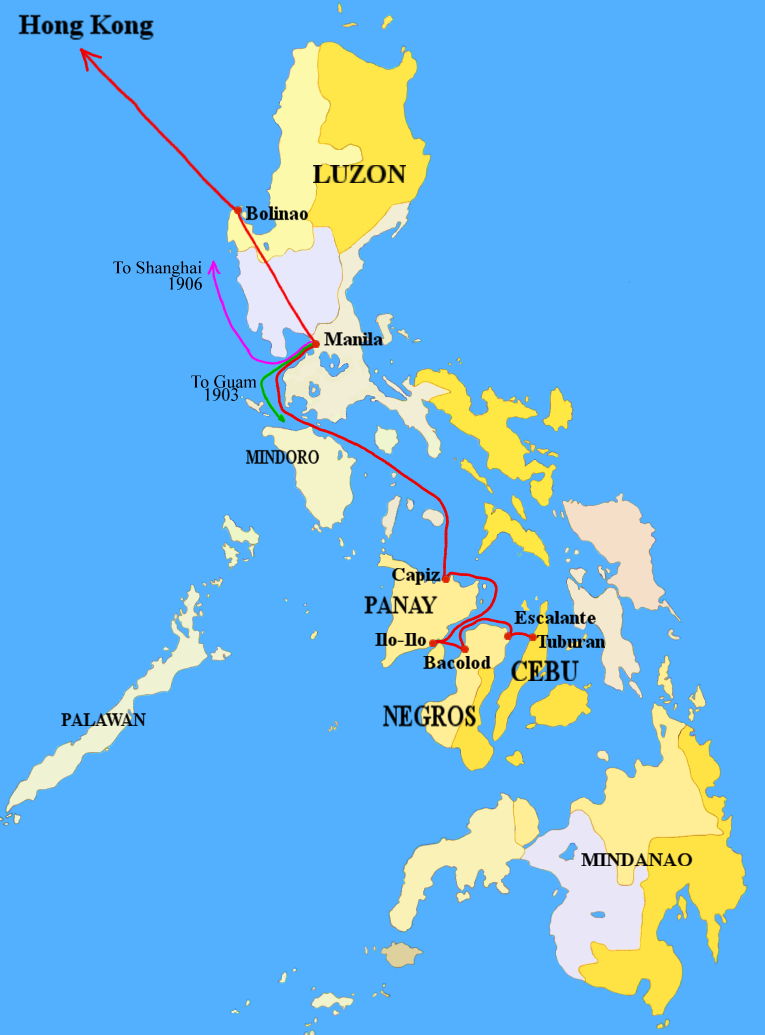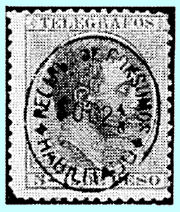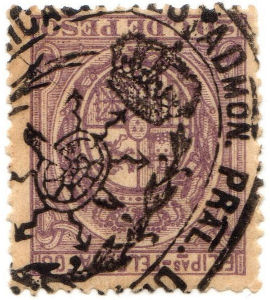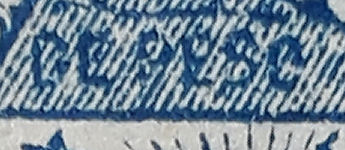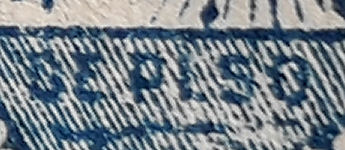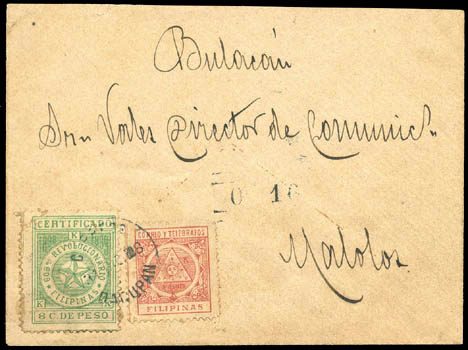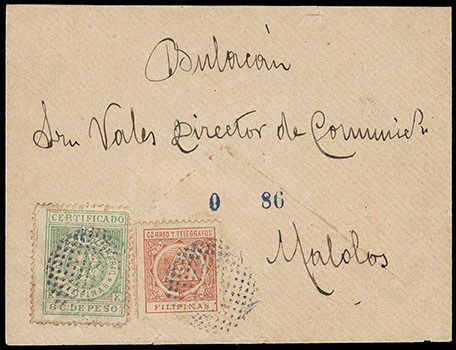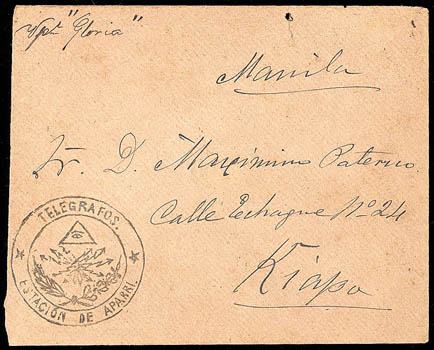| Up a level | ||||||||||
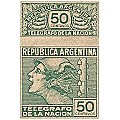 |
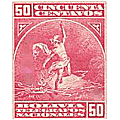 |
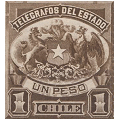 |
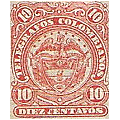 |
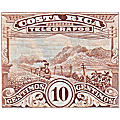 |
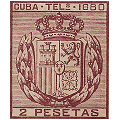 |
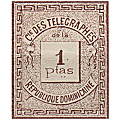 |
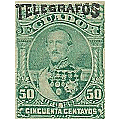 |
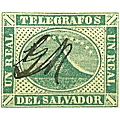 |
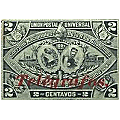 |
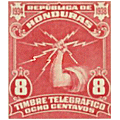 |
| Argentina | Bolivia | Chile | Colombia | Costa Rica | Cuba | Dominican Rep. | Ecuador | El Salvador | Guatemala | Honduras |
| Up a level | ||||||||||
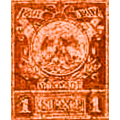 |
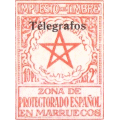 |
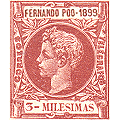 |
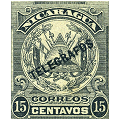 |
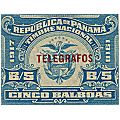 |
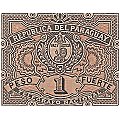 |
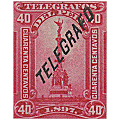 |
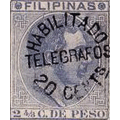 |
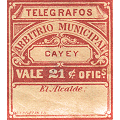 |
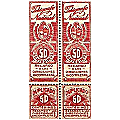 |
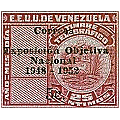 |
| Mexico | Morocco | Guinea | Nicaragua | Panama | Paraguay | Peru | Philippines | Puerto Rico | Uruguay | Venezuela |
I have brought these prices up to date and added currency selection. I have made some additions and given them 'RH' (Revised Hiscocks) numbers to preserve the original Hiscocks numbers and avoid confusion. The RH number is the same as the Hiscocks number if not otherwise specified. CheckList Setup |
| Shortcuts to other sections | |||||
| 1889 | Revisado | Correos y Telegrafos | Revolutionary Government | Canton Isla Negros | Telegraphic Usage. |
Hiscocks added the following note:
| Note. Up to about 1880 the normal cancellation was a roughly circular hole of about 5mm diameter. Handstamped cancellations of black bars, etc. are also found. |
1876-1882 Alfonso XII, white wove paper. No watermark. Perf. 14
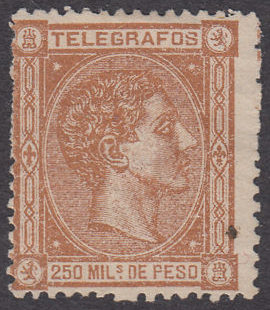 |
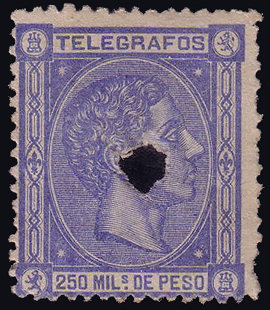 |
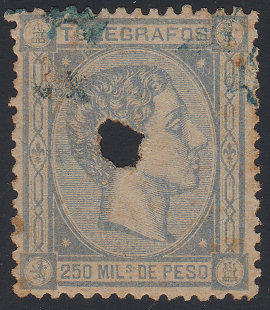 |
| Type 2 - H2 | Type 2 - H3 Courtesy of Rolf Lamprecht |
Type 3a - H3a |
| Hisc. | Type. | Description | Mint | Used |
|---|---|---|---|---|
| H2 | 2 | 250m light brown | 15.00 | 4.00 |
| H2a | imperf. | 25.00 | - | |
| H3 | 2 | 250m deep ultramarine | 30.00 | 4.00 |
| H3a | dull violet-blue | 30.00 | 4.00 |
1880-1881 Alfonso XII (new design), white wove paper. No watermark. Perf. 14
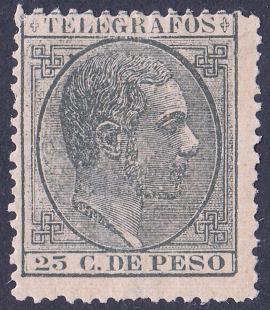 |
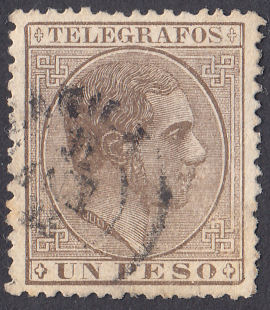 |
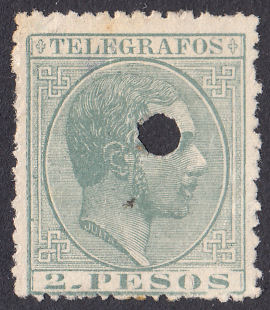 |
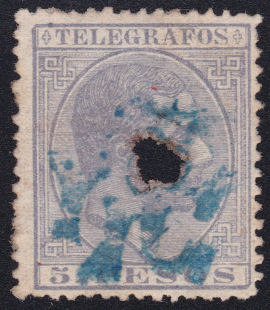 |
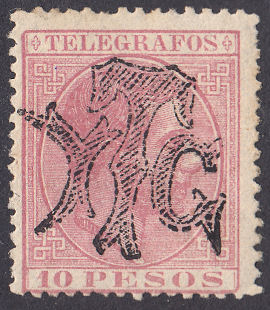 |
| Type 3 (H4) | Type 3 (H5) | Type 3 (H6) | Type 3 (H7) See also note 5 below H22. |
Type 3 (H8) See also note 5 below H22. |
| Hisc. | Type. | Description | Mint | Used |
|---|---|---|---|---|
| H4 | 3 | 25c blue-grey | 20.00 | 3.00 |
| H5 | 3 | 1p brown | 12.00 | 2.00 |
| H6 | 3 | 2p dull blue-green | 12.00 | 2.00 |
| H7 | 3 | 5p violet grey | 20.00 | 2.00 |
| H8 | 3 | 10p lake | 50.00 | 4.00 |
1881 - Revenue stamp of 1878 (Forbin No. 13 of Judicial) overprinted as type 5 in black. No watermark. Perf. 14
It is unclear why this was done since the face value of 2 Reales is equivalent to the 25c stamp above.
According to Wiki the Real was replaced in 1852 and went out of circulation in 1864,
so perhaps they wanted to make use of these rather than printing more 25c.
But that does not explain why the Forbin No. 13 was produced with values in Reales in 1878 (when the Real went out of use in 1852)
and not replaced with values in Pesos until 1882. I suspect the Wiki is wrong with its dates.
Steve Hiscocks quoted July 1881 for this, but the only example I have seen is on a form dated 8 April 1881 (shown near the bottom).
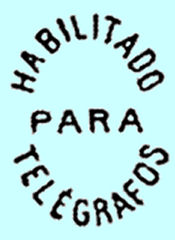 |
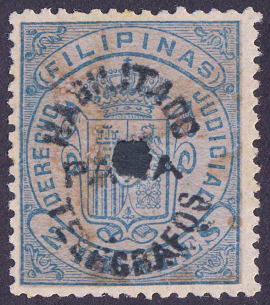 |
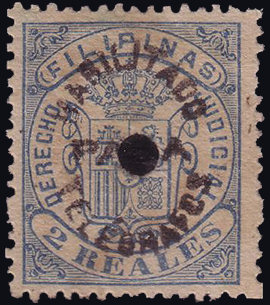 |
| Type 5 | H9 | Another H9 courtesy of Rolf Lamprecht |
| Hisc. | Type. | Description | Mint | Used |
|---|---|---|---|---|
| H9 | 4, 5 | 2 reales (25c) blue | 60.00 | 10.00 |
My note: many of the following use fractions with a denominator of 8 (pieces of eight ?) — i.e. 2/8 or 4/8.
This is probably because 1 Peso = 8 Reales.
Since I cannot easily represent such fractions on the computer screen,
I have replaced them with the normally used arithmetic equivalent of ¼ or ½.
1885(?) Postage stamp of 1880-82 (SG 95) overprinted as type 7 or 8 in red. White wove paper. No watermark. Perf. 14
The example of type 6 shows that they were being used telegraphically before the overprint was added.
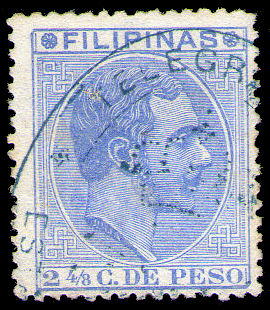 |
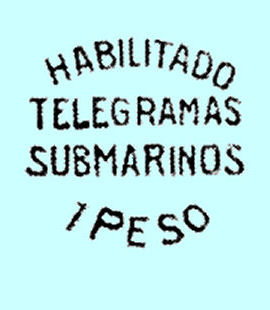 |
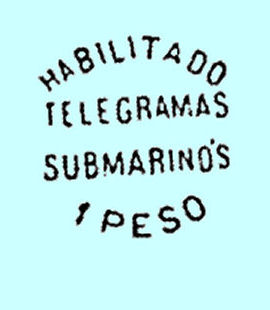 |
| Type 6 | Type 7 | Type 8 |
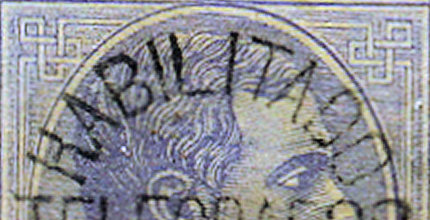 |
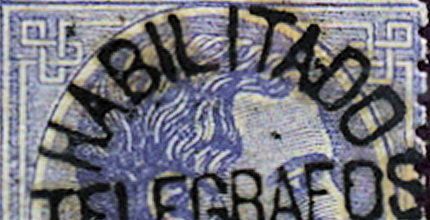 |
| Type 9 - Courtesy of Rolf Lamprecht | Type 10 - Courtesy of Rolf Lamprecht |
Hairline differences as in note below.
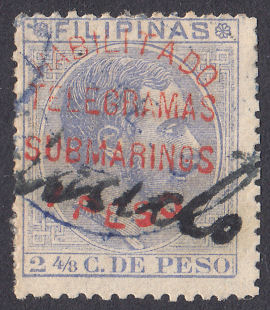 |
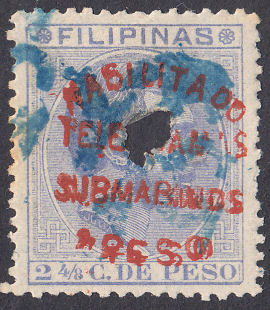 |
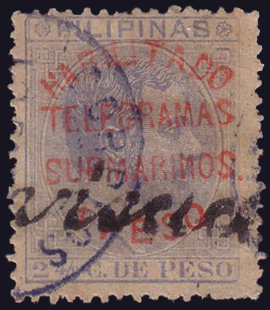 |
| H10 | H10a | RH10b "SUBMARIИOS" Courtesy of Rolf Lamprecht |

N reversed.
| RH # | Hisc. | Type. | 1885 Description | Mint | Used |
|---|---|---|---|---|---|
| RH10 | H10 | 6, 7, 9 | 1p on 2½c dull ultramarine (shades) | 20.00 | 1.00 |
| RH10a | H10a | 6, 8, 9 | overprint similar but smaller (2mm letters at top) | 20.00 | 1.00 |
| RH10b | - | 6, 7, 9 | N reversed - "SUBMARIИOS" | - | - |
| RH11 | H11 | 6, 7, 10 | on stamp of second type (see note below) | 20.00 | 1.00 |
| RH11a | H11a | 6, 8, 10 | as No. 11 but smaller overprint | 20.00 | 1.00 |
| RH11b | - | 6, 7, 10 | N reversed - "SUBMARIИOS" | - | - |
Hiscocks added the following note:
| Note. SG 95 exists in several forms, two of which were overprinted for telegraphic use. In one the hair line at the temple is pointed and highlighted with a white strip: in the other the hairline is more rounded and the white strip is absent. See illustrations 9 and 10 [ABOVE]. |
1885-1887 Postage stamps of 1880-82 (SG 95 and, in one case SG 94) overprinted and surcharged in various types and colours as indicated below.
White wove paper. No watermark. Perf. 14
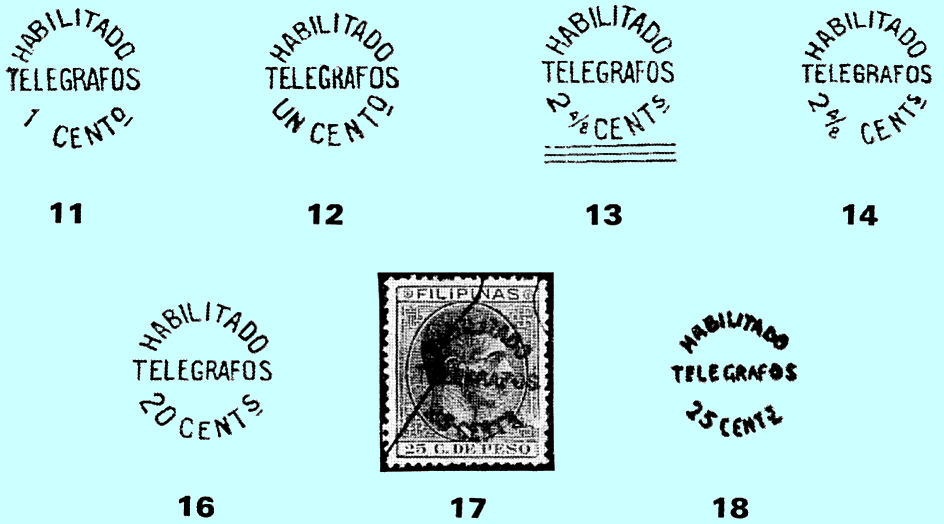
Types 11-18 from Hiscocks book page 244
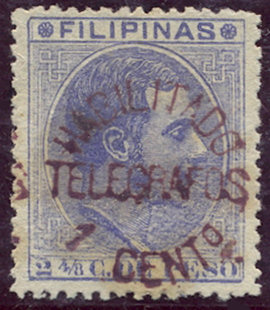 |
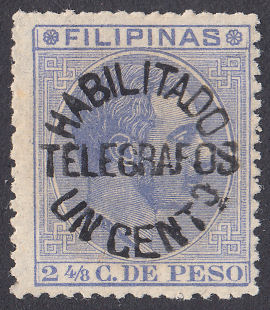 |
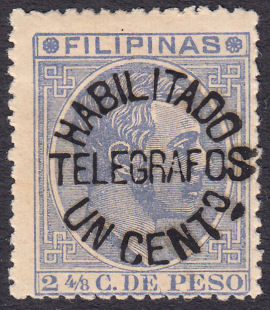 |
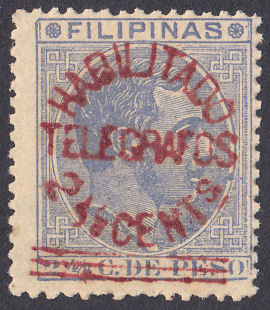 |
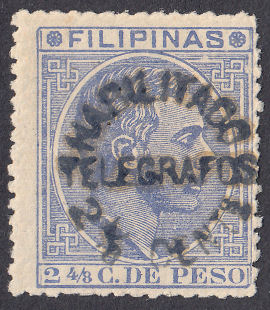 |
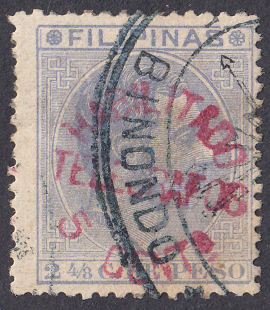 |
| H12 - Courtesy of Rolf Lamprecht | H13 - Type 9. | H14 - Type 10. | H15 | H16 | H17 |
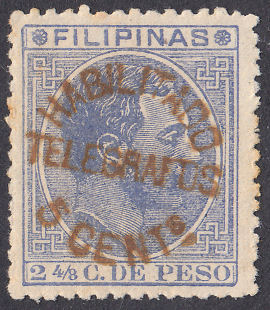 |
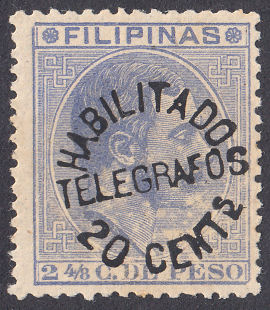 |
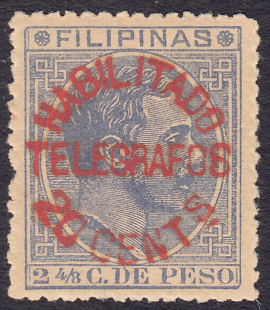 |
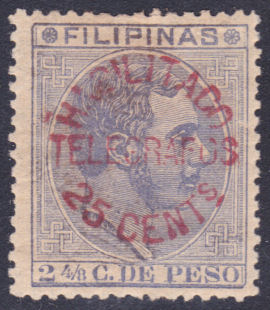 |
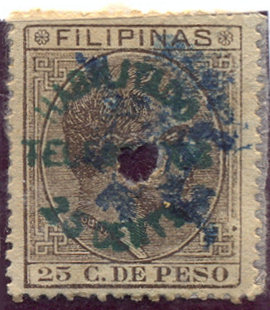 |
| H18 | H19 | H20 | H21 Courtesy of Mathew Stephenson. |
H22 - Courtesy of Rolf Lamprecht |
| RH # | Hisc. | Type. | Description | Mint | Used |
|---|---|---|---|---|---|
| RH12 | H12 | 6, 9, 11 | 1c on 2½c dull ultramarine in violet | 2.00 | 1.00 |
| RH13 | H13 | 6, 9, 12 | 1c on 2½c dull ultramarine in black (Jan. 1887) | 20.00 | 8.00 |
| RH14 | H14 | 6, 10, 12 | 1c on 2½c dull ultramarine in black (Jan. 1887) | 2.00 | 1.00 |
| RH15 | H15 | 6, 9, 13 | 2½c on 2½c dull ultramarine in carmine (7.3.86) | 2.00 | 1.00 |
| RH16 | H16 | 6, 10, 14 | 2½c on 2½c dull ultramarine in blue (7.3.86) | 2.00 | 1.20 |
| RH16a | H16a | overprint in black | 4.00 | 2.00 | |
| RH17 | H17 | 6, 9, (13) | 5c on 2½c dull ultramarine in carmine (7.3.86) | 2.40 | 1.00 |
| RH18 | H18 | 6, 10, (13) | 5c on 2½c dull ultramarine in brown-yellow (Jan. 1887) | 3.00 | 1.00 |
| RH19 | H19 | 6, 9, 16 | 20c on 2½c dull ultramarine in black (7.3.86) | 4.00 | 2.00 |
| RH20 | H20 | 6, 10, 16 | 20c on 2½c dull ultramarine in vermilion (Jan. 1887) | 4.00 | 2.00 |
| RH21 | H21 | 6, 9, (18) | 25c on 2½c dull ultramarine in carmine (10.3.85) | 20.00 | 4.00 |
| RH22 | H22 | 17, 18 | 25c on 25c brown (SG94) in green (10.3.85) | 15.00 | 2.00 |
Hiscocks added the following 5 notes:
| Note 1. Where a type number is in brackets, the particular overprint is not illustrated but is similar to that indicated. |
| Note 2. No. 16 is listed in all catalogues as having a blue overprint but my copy has a black overprint which I have shown as a variety (No. 16a) pending clarification. |
| Note 3. The dates of this series are uncertain. Morley gives 1885 while others give 1882-88. The specific dates given above are taken from W. C. Stones listing in 'The American Philatelist' 1891. |
| Note 4. There are reported to be many variants on the above overprints — double printings, inverteds, etc. These would command a premium of x5-x10 but have not been listed separately for lack of specific information. |
| Note 5. Punched cancellations had apparently been abandoned in the 1880-85 period and the provisionals are normally cancelled with a special oval office stamp with a 'burst of thunderbolts' motif in the centre — black or, less often, blue. Pen cancels are also commonly found as is a blue handstamp with a large 'T' in thick wavy style and smaller letters 'Y' and 'G' on either side, thus YTG . |
For examples of the 'YTG' cancel in note 5, see H7, H8 & H11a above.
Nigel Gooding provides the following useful information:
"This is actually YTC (fancy C). It stands for Ynternational Telegraph Company
(Y being used during the Spanish period). This company was known in
Manila from 1881 through early 1890s. Believed to be a private firm
under contract to the Spanish Government to operate the telegraph
service in Manila during the 1880s. They sometimes overprinted the
stamps affixed to the telegraphs with the YTC cancel (with or without
application of the telegraph punch hole)."
1886 Type similar to that of 1880 (Alfonso XII) in new colours and values. White wove paper. No watermark. Perf. 14
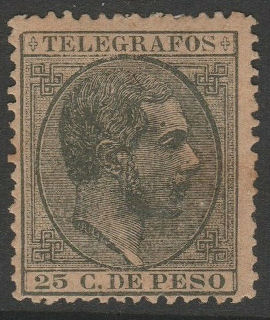 |
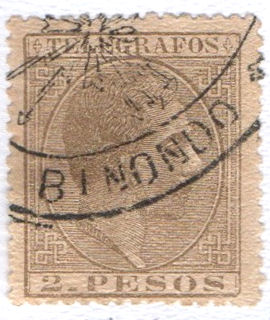 |
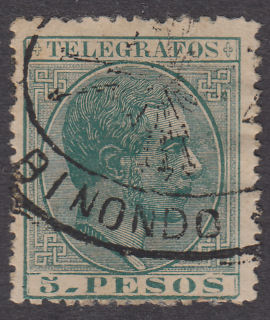 |
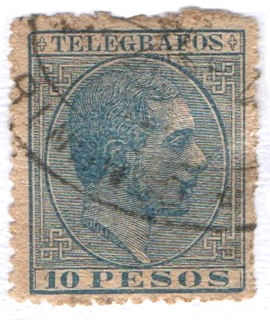 |
| Type 19 (H23) courtesy of treasurings-jewelry |
Type 19 (H24) Courtesy of Paul & Les Bottomley |
Type 19 (H25) | Type 19 (H26) Courtesy of Paul & Les Bottomley |
| Hisc. | Type. | 1886 Description | Mint | Used |
|---|---|---|---|---|
| H23 | 19 | 25c bronze-green | 3.00 | 1.50 |
| H24 | 19 | 2p sepia | 20.00 | 2.00 |
| H25 | 19 | 5p blue green | 40.00 | 2.00 |
| H26 | 19 | 10p dark blue | 40.00 | 2.00 |
1888 As above. New values and colours.
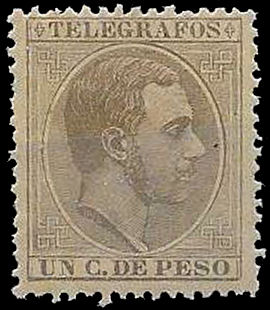 |
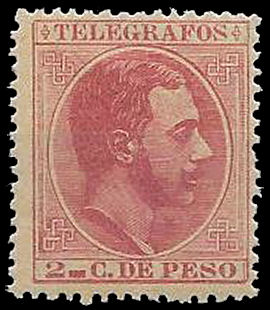 |
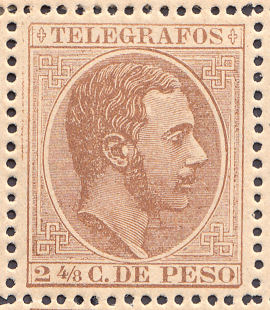 |
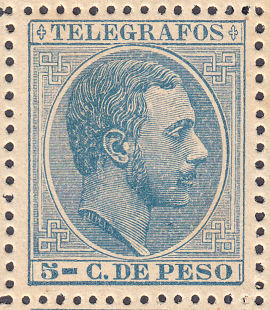 |
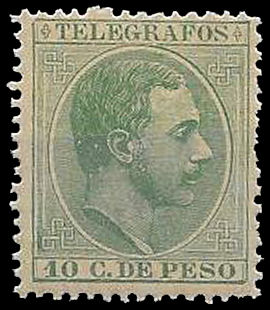 |
| Type 19 (H27) Courtesy of maseratiaxel on eBay. |
Type 19 (H28) Courtesy of maseratiaxel on eBay. |
Type 19 (H29) | Type 19 (H30) | Type 19 (H31) Courtesy of maseratiaxel on eBay. |
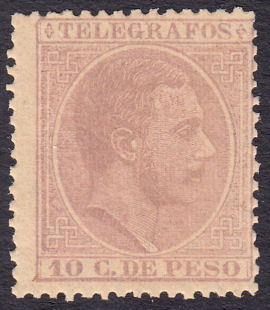 |
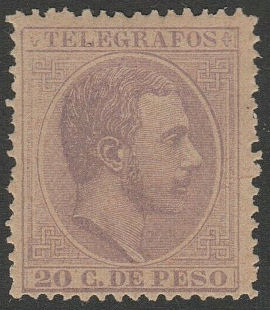 |
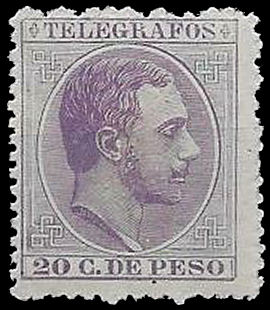 |
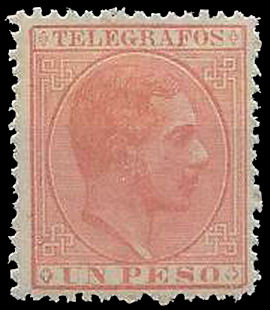 |
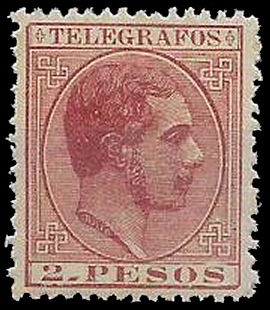 |
| Type 19 (H32) | Type 19 (H34) courtesy of treasurings-jewelry |
Type 19 (H34a) Courtesy of maseratiaxel on eBay. |
Type 19 (H35) Courtesy of maseratiaxel on eBay. |
Type 19 (H36) Courtesy of maseratiaxel on eBay. |
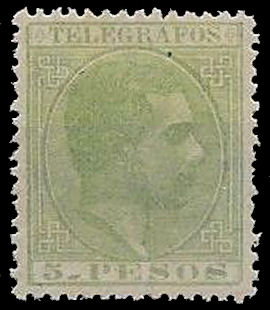 |
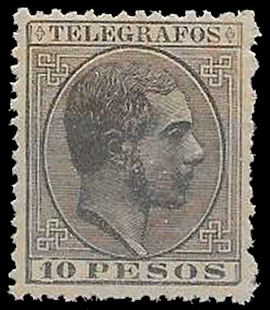 |
| Type 19 (H37) Courtesy of maseratiaxel on eBay. |
Type 19 (H38) Courtesy of maseratiaxel on eBay. |
| RH # | Hisc. | Type. | Description | Mint | Used |
|---|---|---|---|---|---|
| RH27 | H27 | 19 | 1c olive-sepia | 2.00 | 1.00 |
| RH27a | H27a | pale olive-sepia | 2.50 | 1.00 | |
| RH28 | H28 | 19 | 2c carmine | 50.00 | 12.00 |
| RH29 | H29 | 19 | 2½c brown | 1.00 | 0.80 |
| RH29a | H29a | dark brown | 6.00 | 4.00 | |
| RH30 | H30 | 19 | 5c blue | 1.00 | 0.80 |
| RH31 | H31 | 19 | 10c yellow-green | 80.00 | 20.00 |
| RH32 | H32 | 19 | 10c lilac | 2.00 | 0.80 |
| RH32a | H32a | deep lilac | 15.00 | 4.00 | |
| RH33 | H33 | 19 | 10c brown | 4.00 | 0.80 |
| *RH33a | - | imperf. | - | - | |
| RH34 | H34 | 19 | 20c pale dull lilac | 2.00 | 0.80 |
| RH34a | H34a | deep dull lilac | 8.00 | 4.00 | |
| RH35 | H35 | 19 | 1p rose | 60.00 | 8.00 |
| RH36 | H36 | 19 | 2p carmine | 8.00 | 2.00 |
| RH37 | H37 | 19 | 5p yellow-green | 40.00 | 1.20 |
| RH38 | H38 | 19 | 10p dark brown | 40.00 | 8.00 |
*Added due to example seen.
Hiscocks added the following note:
| Note. No. 31 is said to have been for 'Postal Union' use. |
1889
Hiscocks also gave this general note:
For ease of reference, this is (my interpretation of) the list of Fiscal stamps authorized for use as Telegraph stamps, as in the General Note above.
The Forbin list of these is on page 350 of the third edition (1915). Number 33 is the last on the page, and the next page is a new section.
Rather an abrupt finish.
| My Ref. No. | Forbin No. | Description | Authorized | Seen by Hiscocks | Forbin Price (Fr) |
|---|---|---|---|---|---|
| - | 23 | 2½c on 1c olive-sepia (H27) | No | ? | 2.50 |
| - | 24 | 2½c on 2c carmine (H28) | No | ? | 1.00 |
| - | 25 | 2½c on 2½c brown (H29) | No | ? | 0.30 |
| - | 26 | 2½c on 5c blue (H30) | No | Yes | 0.25 |
| - | 27 | 2½c on 10c yellow-green (H31) | No | ? | 0.25 |
| - | 28 | 2½c on 10c lilac (H32) | No | ? | 2.50 |
| - | 29 | 2½c on 20c lilac (H34) | No | ? | 1.00 |
| F1 | 30 | 5c on 20c lilac (H34) | Yes | Yes | 0.75 |
| F2 | 31 | 7½c on 20c lilac (H34) | Yes | Yes | 25.00 |
| F3 | 32 | 10c on 20c lilac (H34) | Yes | Yes | 12.50 |
| F4 | 33 | 11¼c on 20c lilac (H34) | Yes | No | 30.00 |
| F5 | - | 17½c on 20c lilac (H34) | Yes | No | - |
| - | - | 25c on 20c lilac (H34) | Yes | No | - |
| - | - | 40c on 20c lilac (H34) | Yes | No | - |
| - | - | 75c on 20c lilac (H34) | Yes | No | - |
| - | - | 1p on 20c lilac (H34) | Yes | No | - |
| - | - | 1.25p on 20c lilac (H34) | Yes | No | - |
This implies that other values, or on postage stamps, such as these 2½c on various values (F19, F21, F29, F17):

Were NOT authorized for Telegraphic use, and remained Fiscal stamps. Forbin 16-22 was this overprint on similar postage stamps.
However these were authorized:
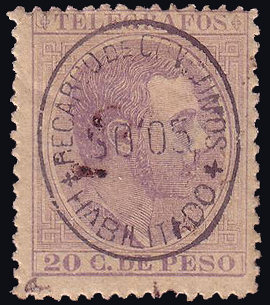 |
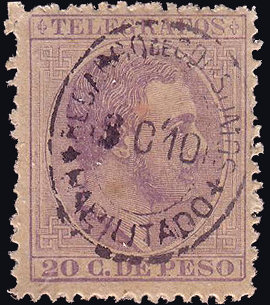 |
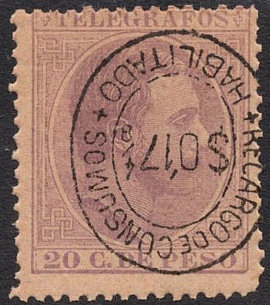 |
| F1 (Forbin 30) Courtesy of Rolf Lamprecht |
F3 (Forbin 32) Courtesy of Rolf Lamprecht |
F5? - (inverted overprint) Courtesy of LiquidationGirl on eBay |
I am not convinced that the last has a genuine overprint, the + symbols are noticeably smaller.
Having said all that, usage of stamps for telegraphic purposes in the Philippines (and many other places)
was not always constrained by what was authorized.
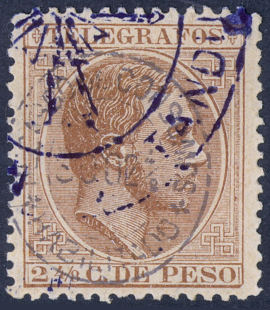
Here is an example of Forbin F25 with a Telegraph cancel.
The image is supplied by Harry Patsalos who tells me that he has about half a dozen like this, all with gum.
The cancel is of Tanduay, famous for its Rum Distillery.
There are plenty of examples that show telegraphic use of stamps intended for other purposes. I also know that in busy offices using stamps,
many of them pre-cancelled stamps to save time at peak periods.
My feeling is that these were pre-cancelled for telegraph use, perhaps for receipts, regardless of authorization.
I would welcome further similar examples, with or without gum.
A block of Forbin #26 (half size) courtesy of Mathew Stephenson
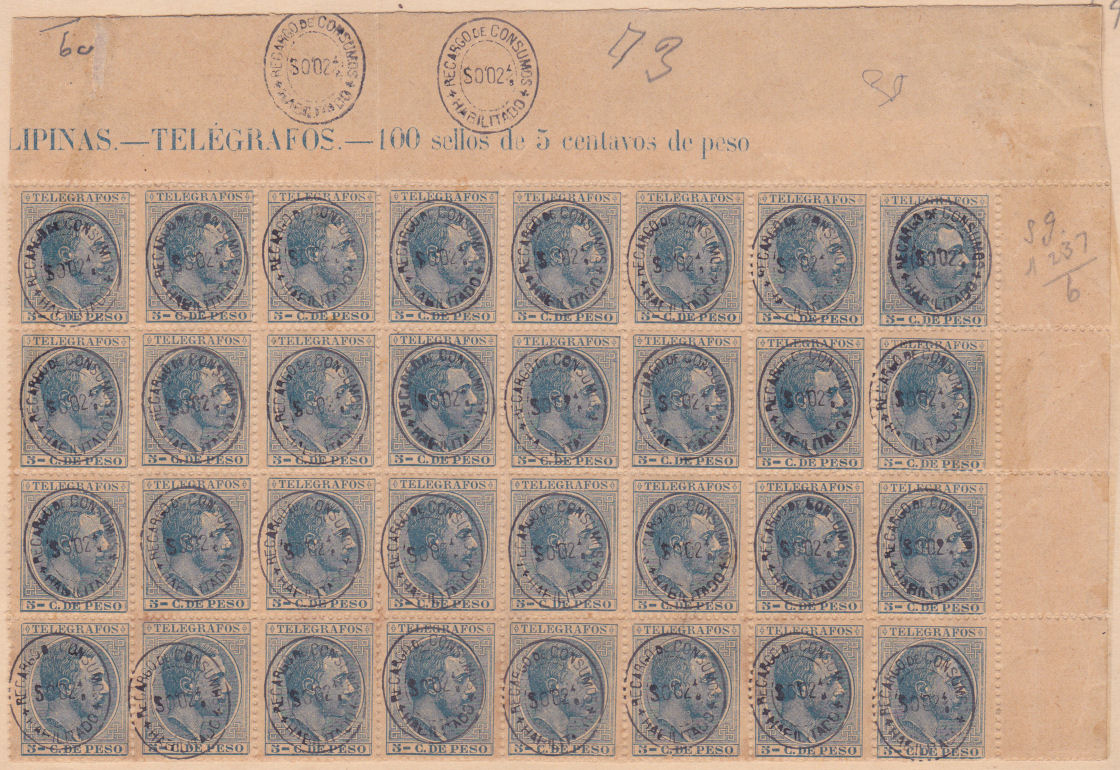
Revisado.
1889 (1 January or perhaps earlier) Revisado (Revised) Handstamp.

According to Nigel Gooding, citing Don Peterson, IPPS Newsletter, 4th Quarter 1997,
though
this looks like a manuscript cancel, it is a handstamp that was intended to be applied to
surcharged stamps on telegraph receipts to return the value to what it was without the surcharge.
This is thought to have been due to a shortage of low-value telegraph stamps at the time.
The handstamp was of a size that fitted across two stamps:
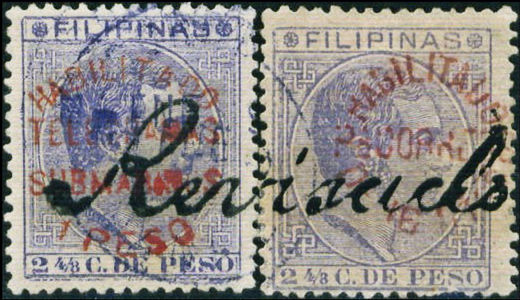
As in this example, not all stamps on telegraph receipts were telegraph stamps.
Over-enthusiastic (or indiscriminate) application results in the handstamp being found on non-surcharged stamps also.
The handstamp was more likely to have been used on stamps with a high-value surcharge, but in principle could be applied to anything available.
Dated known examples are mostly in the range of January to April 1889, with a few later. My example of H11 above has this, I have also seen it on H23.
He Notes: It is anticipated that the majority of the 1881 to 1888 Postal issues exist with the 'Revisado' handstamp.
He also says "All loose (off-paper) stamps with this handstamp would have been removed from the original telegraph receipts,
and as a result, are technically classified as Telegraphic used issues, as opposed to Postal issues."
My thanks to Nigel Gooding for this information and images.
Anyone have a complete receipt showing this ?
1890 (January) New design. White wove paper. No watermark. Perf. 14
Only "TELEGRAFOS" at the top.
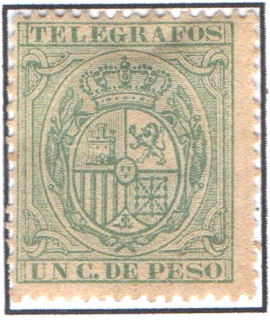 |
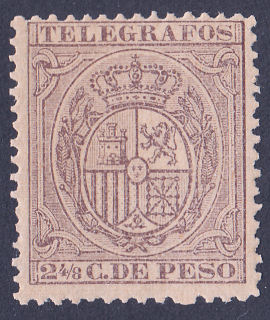 |
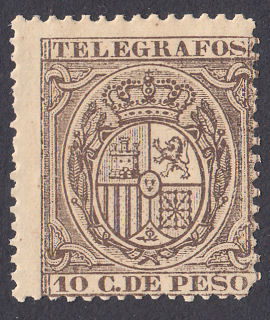 |
| Type 20 (H39) Courtesy of Les Bottomley |
Type 20 (H40) | Type 20 (H42) |
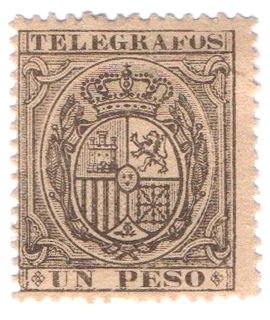 |
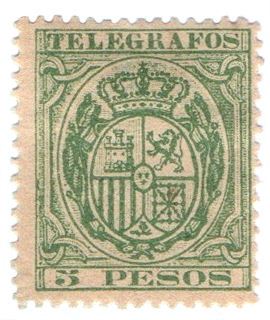 |
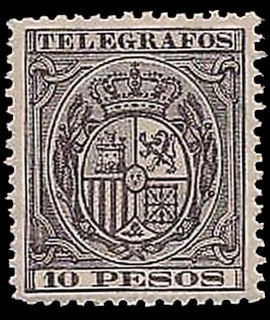 |
| Type 20 (H46) Courtesy of Les Bottomley |
Type 20 (H48) Courtesy of Les Bottomley |
Type 20 (H49) |
| Hisc. | Type. | 1890 Description | Mint | Used |
|---|---|---|---|---|
| H39 | 20 | 1c dull blue-green | 1.60 | 1.20 |
| H40 | 20 | 2½c sepia | 1.60 | 1.20 |
| H41 | 20 | 5c rose | 8.00 | 4.00 |
| H42 | 20 | 10c brown | 8.00 | 4.00 |
| H43 | 20 | 12½c carmine | 6.00 | 4.00 |
| H44 | 20 | 20c deep blue | 6.00 | 4.00 |
| H45 | 20 | 25c brown | 10.00 | 4.00 |
| H46 | 20 | 1p olive-grey | 3.00 | 2.00 |
| H47 | 20 | 2p yellow-brown | 20.00 | 8.00 |
| H48 | 20 | 5p yellow-green | 8.00 | 4.00 |
| H49 | 20 | 10p brown-violet | 20.00 | 6.00 |
Hiscocks added the following note:
| Note. No. 48 is known forged to defraud the authorities — used condition only. Price about £10. |
1891 As above but new colours. See note below.
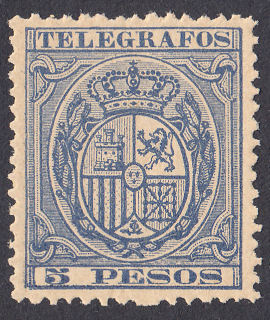 |
| Type 20 (H54) |
| Hisc. | Type. | 1891 Description | Mint | Used |
|---|---|---|---|---|
| H50 | 20 | 1c carmine | 50.00 | 10.00 |
| H51 | 20 | 5c olive-grey | 50.00 | 10.00 |
| H52 | 20 | 12½c dark brown | 50.00 | 10.00 |
| H53 | 20 | 25c green | 50.00 | 10.00 |
| H54 | 20 | 5p ultramarine | 40.00 | 8.00 |
Hiscocks added the following note:
| Note. The status of Nos. 50-53 seems to be in some doubt since they are listed by Galvez (1934) but not by other, later catalogues. They could perhaps be colour trials. No. 54 is not in doubt and is listed in all catalogues from Morley onwards. |
From 1892 to 1897 there were many values and colours in the same design.
In an effort to make it easier to sort them out, I have tabulated them here by value and colour, giving the year and Hiscocks reference.
1892 As above but now inscribed "FILIPAS-TELEGRAPHOS".
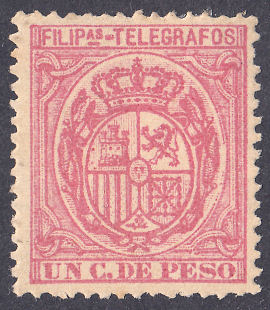 |
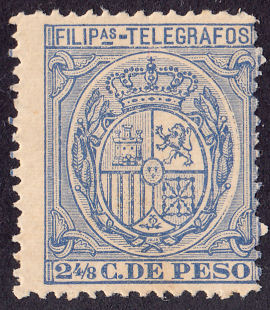 |
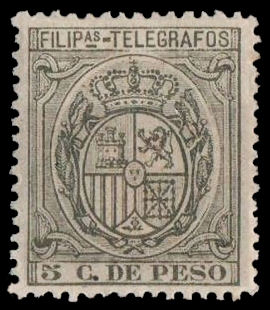 |
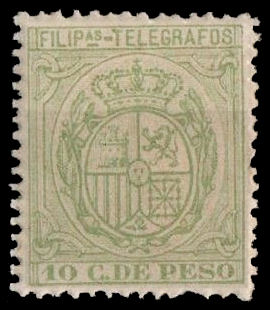 |
| Type 21 (H55) | Type 21 (H56) | Type 21 (H57) | Type 21 (H58) |
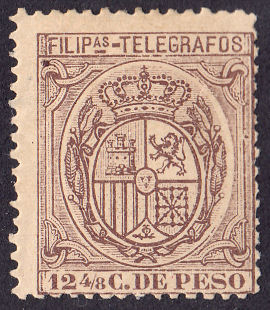 |
 |
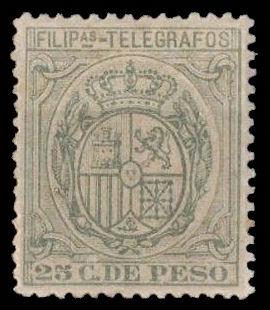 |
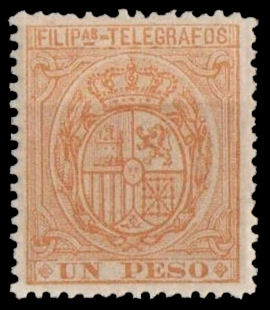 |
| Type 21 (H59) | Type 21 (H60, yellow-brown) | Type 21 (H61) | Type 21 (H62) |
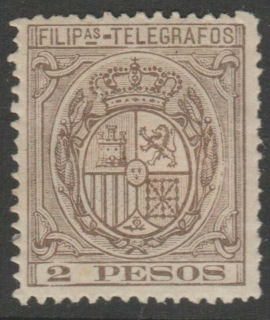 |
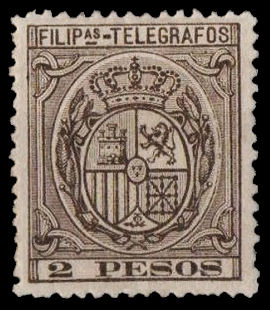 |
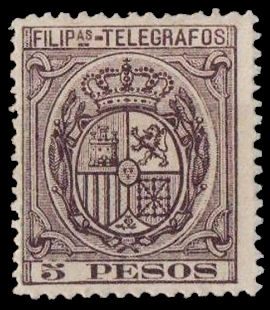 |
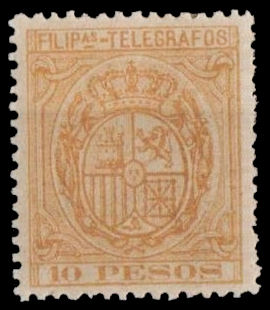 |
| Type 21 (H63) courtesy of treasurings-jewelry |
Type 21 (H63) | Type 21 (H64) | Type 21 (H65) |
| Hisc. | Type. | 1892 Description | Mint | Used |
|---|---|---|---|---|
| H55 | 21 | 1c rose | 2.00 | 1.00 |
| H56 | 21 | 2½c blue | 3.00 | 1.00 |
| H57 | 21 | 5c olive-grey | 6.00 | 2.00 |
| H58 | 21 | 10c green | 3.00 | 2.00 |
| H59 | 21 | 12½c brown-lilac | 3.00 | 1.50 |
| H60 | 21 | 20c yellow-brown | 15.00 | 2.50 |
| H61 | 21 | 25c blue-green | 3.00 | 1.50 |
| H62 | 21 | 1p orange | 6.00 | 1.50 |
| H63 | 21 | 2p brown (shades) | 8.00 | 1.50 |
| H64 | 21 | 5p brown-violet | 8.00 | 2.00 |
| H65 | 21 | 10p vermilion | 25.00 | 6.00 |
1894-1895 As above but with changed colours.
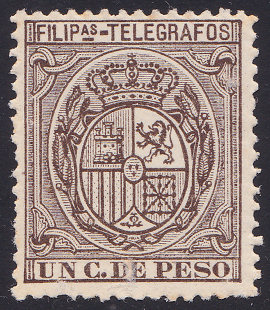 |
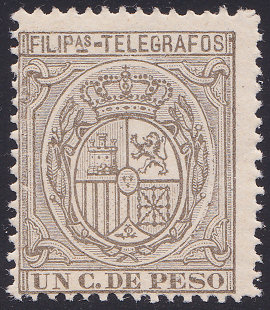 |
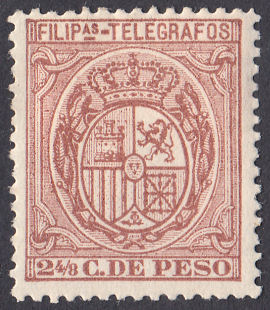 |
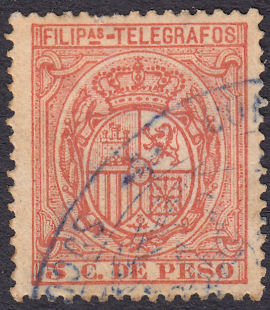 |
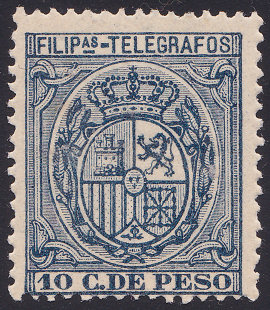 |
| Type 21 (H66) | Type 21 (H67) | Type 21 (H68) | Type 21 (H69) | |
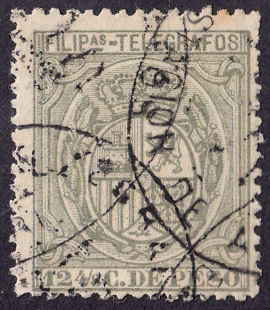 |
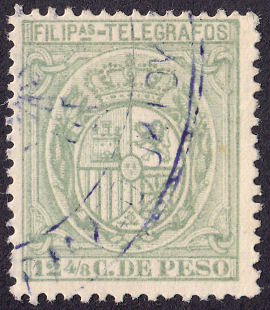 |
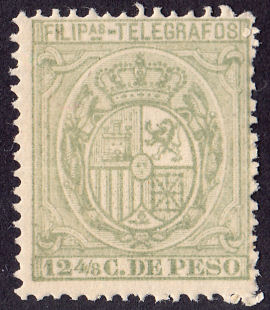 |
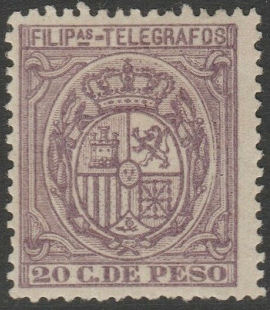 |
| Type 21 (H70/70a) I'm not good at guessing shades, here are 3 shades scanned together. |
Type 21 (H71) courtesy of treasurings-jewelry |
||
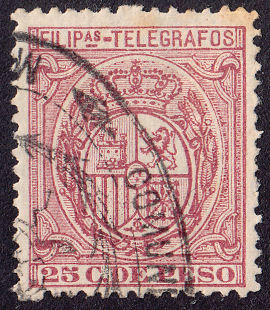 |
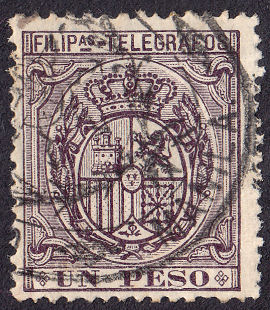 |
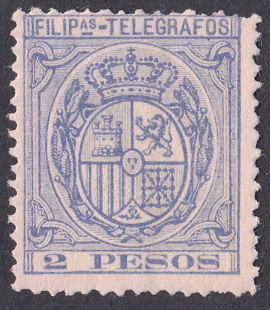 |
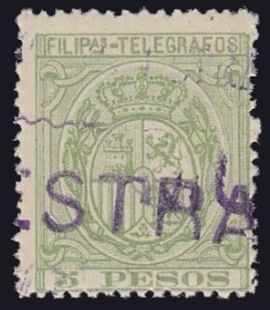 |
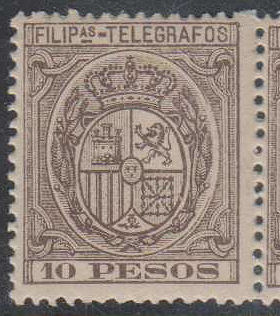 |
| Type 21 (H72) | Type 21 (H73) | Type 21 (H74) | Type 21 (H75) | H76 Courtesy of Victor Gugliano (victorgg) |
| Hisc. | Type. | 1894/5 Description | Mint | Used |
|---|---|---|---|---|
| H66 | 21 | 1c sepia (shades) | 3.00 | 1.50 |
| H67 | 21 | 2½c red-brown | 2.50 | 1.50 |
| H68 | 21 | 5c orange-red | 2.50 | 1.50 |
| H69 | 21 | 10c dark-blue | 2.50 | 1.50 |
| H70 | 21 | 12½c greyish green (1895) | 2.50 | 1.20 |
| H70a | olive (1895) | 40.00 | 1.50 | |
| H71 | 21 | 20c violet brown (1895) | 15.00 | 1.50 |
| H72 | 21 | 25c carmine | 8.00 | 1.50 |
| H73 | 21 | 1p violet-black (1895) | 8.00 | 1.50 |
| H74 | 21 | 2p pale ultramarine (1895) | 15.00 | 1.50 |
| H75 | 21 | 5p yellow green | 20.00 | 1.50 |
| H76 | 21 | 10p brown violet | 25.00 | 5.00 |
Hiscocks added the following note:
| Note. Morley separates Nos. 66-77 (SIC) into those of 1894 and 1895 but does not list Nos. 75 & 76 at all. The year of issue of Nos. 75 and 76 is therefore uncertain. |
1896 As above but with changed colours.
 |
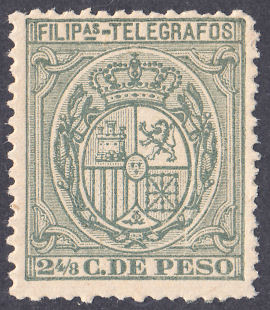 |
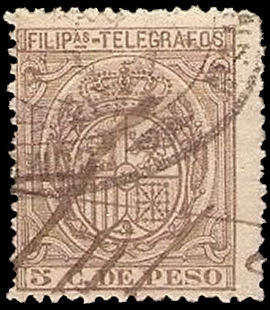 |
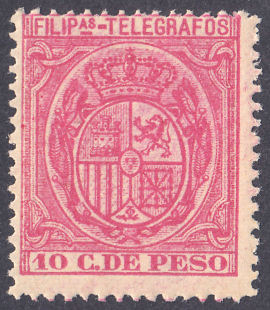 |
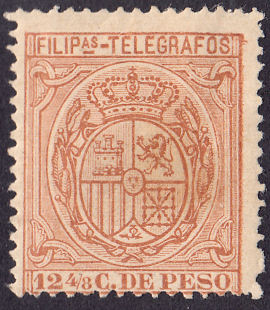 |
| Type 21 (H77-olive-grey) | Type 21 (H78) | Type 21 (H79) | Type 21 (H80) | Type 21 (H81) |
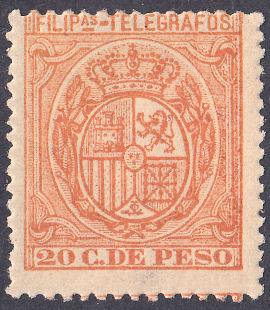 |
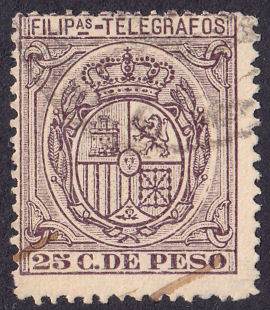 |
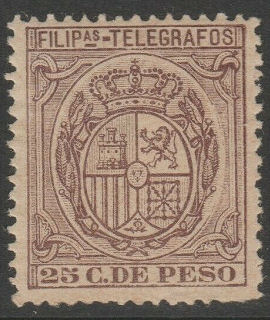 |
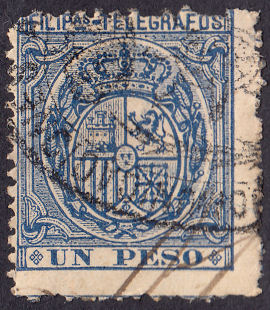 |
| Type 21 (H82) | Type 21 (H83) | Type 21 (H83 yellowed paper) courtesy of treasurings-jewelry |
Type 21 (H84) |
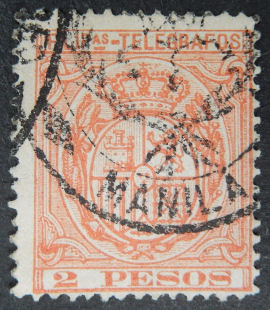 |
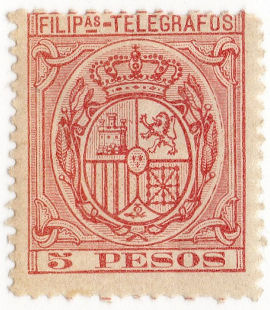 |
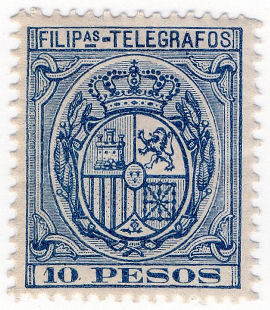 |
| Type 21 (H85) | Type 21 (H86) Image courtesy of ibredguy.co.uk. |
Type 21 (H87) Image courtesy of ibredguy.co.uk. |
1897 No. 71 above overprinted as indicated in black.
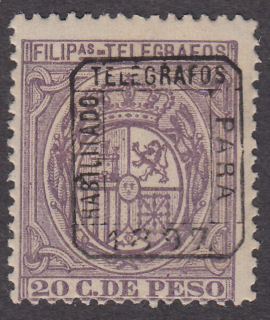 |
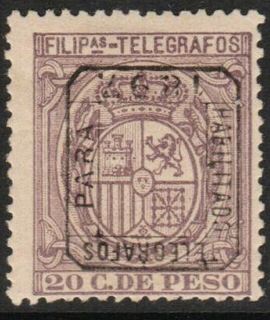 |
| Type 22 overprint | H88a inverted overprint courtesy of treasurings-jewelry |
| Hisc. | Type. | 1897 Description | Mint | Used |
|---|---|---|---|---|
| H88 | 21, 22 | 20c violet | 6.00 | 1.50 |
| H88a | inverted overprint. | - | - |
Correos y Telegrafos.
1898/9 Stamps were then issued intended for both postal and Telegraphic usage:
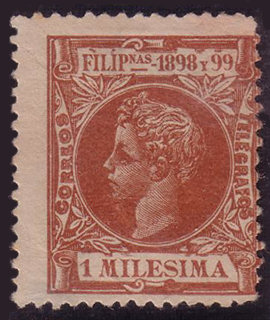 |
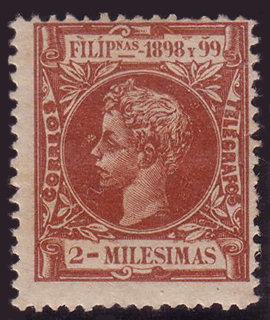 |
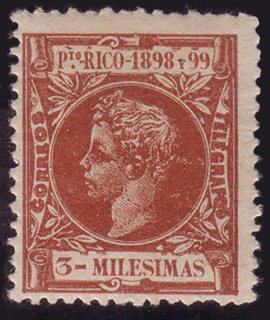 |
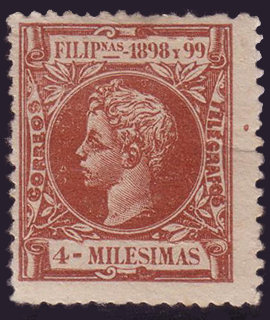 |
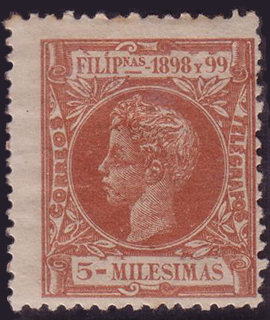 |
| 1898 - 1m | 1898 - 2m | 1898 - 3m | 1898 - 4m | 1898 - 5m |
The values below 1c may only have been used for newspapers.
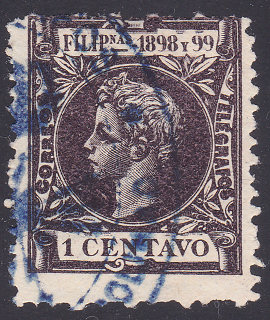 |
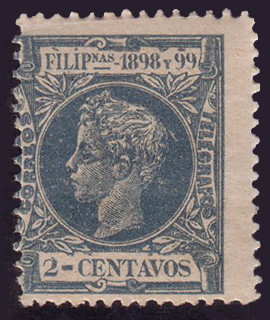 |
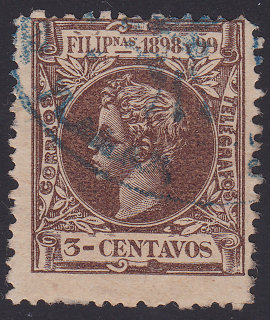 |
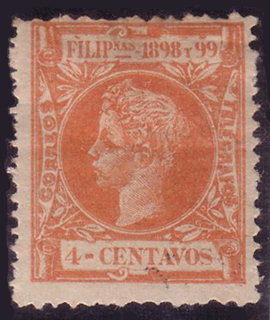 |
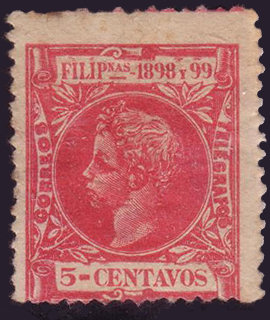 |
| 1898 - 1c | 1898 - 2c | 1898 - 3c | 1898 - 4c | 1898 - 5c |
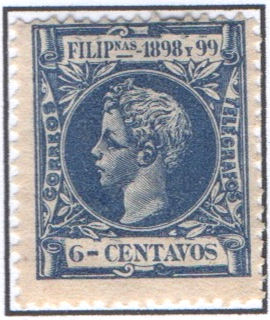 |
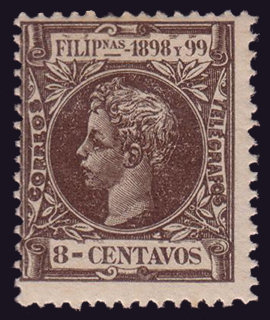 |
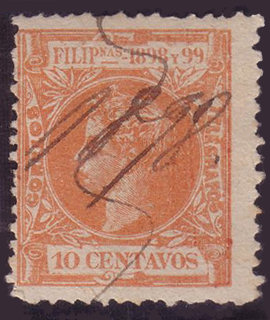 |
 |
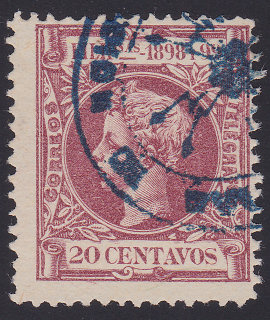 |
| 1898 - 6c Courtesy of Les Bottomley |
1898 - 8c | 1898 - 10c | 15c needed | 1898 - 20c |
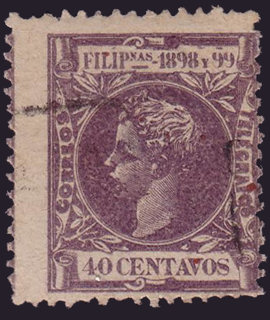 |
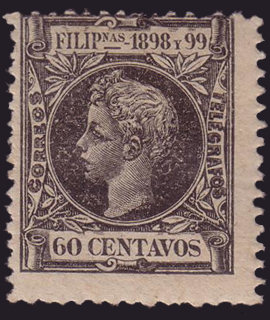 |
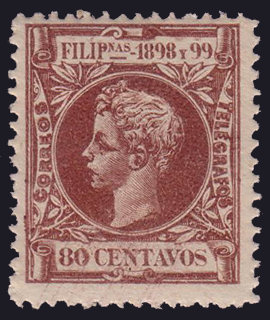 |
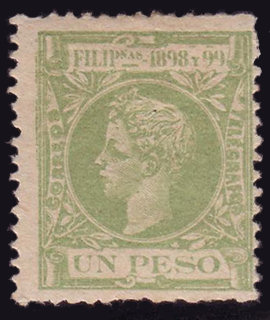 |
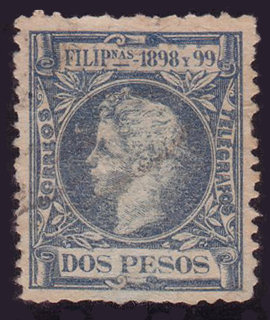 |
| 1898 - 40c | 1898 - 60c | 1898 - 80c | 1898 - 1P | 1898 - 2P |
Type CyT. telegraphic usage can only be established by the cancel. Surviving examples telegraphically used are not common,
despite low catalogue prices for postally used ones. The 3c and 20c are mine. All the rest except those marked as Les Bottomley are courtesy of Rolf Lamprecht.
With 20 different values, it must have been hard choosing 20 different colours. The 2c and 2P look about the same (though have different descriptions).
| RH # | Type. | 1878 Description | Mint | Postally Used | Telegraphically Used |
|---|---|---|---|---|---|
| CT1 | CyT | 1m orange-brown (shades) | 0.20 | 1.00 | - |
| CT2 | CyT | 2m orange-brown (shades) | 0.20 | 1.00 | - |
| CT3 | CyT | 3m orange-brown (shades) | 0.20 | 1.25 | - |
| CT4 | CyT | 4m orange-brown (shades) | 7.00 | 30.00 | - |
| CT5 | CyT | 5m orange-brown (shades) | 0.20 | 2.00 | - |
| CT6 | CyT | 1c violet black | 0.20 | 0.45 | - |
| CT7 | CyT | 2c dark blue-green | 0.20 | 0.45 | - |
| CT8 | CyT | 3c dark brown | 0.20 | 0.45 | - |
| CT9 | CyT | 4c orange | 17.00 | 35.00 | - |
| CT10 | CyT | 5c carmine-rose | 0.20 | 0.45 | - |
| CT11 | CyT | 6c dark blue | 0.90 | 1.25 | - |
| CT12 | CyT | 8c grey-brown | 0.40 | 0.25 | - |
| CT13 | CyT | 10c vermilion | 1.50 | 1.00 | - |
| CT14 | CyT | 15c olive-green | 1.50 | 0.85 | - |
| CT15 | CyT | 20c maroon | 1.60 | 1.10 | - |
| CT16 | CyT | 40c violet | 0.90 | 1.25 | - |
| CT17 | CyT | 60c black | 3.50 | 3.00 | - |
| CT18 | CyT | 80c red-brown | 16.00 | 4.00 | - |
| CT19 | CyT | 1P yellow-green | 11.00 | 13.00 | - |
| CT20 | CyT | 2P slate-blue | 25.00 | 16.00 | - |
Revolutionary Government.
The Spanish–American War began in 1898. According to the Scott catalogue:
| The Spanish surrendered in May 1898. Some Filipinos continued to fight until 1901. During this period provisional stamps were created in several areas. Some of these stamps may have been totally philatelic. See the Scott Specialized Catalogue of U. S. Stamps for stamps issued by Gen. Aguinaldo's Filipino Revolutionary Government. |
My note: A guide as to which were purely philatelic is to see which ones are known used.
As always, it is for the collector to decide what to collect.
1898 Stamps of the Revolutionary Government of General Emilio Aguinaldo. White wove paper. No watermark. Perf. 11½
Sheets of 192 stamps, 16 rows of 12, lithographed by the Lithographia del Gomes in Santa Cruz, Manila.
About 19000 of each was printed.
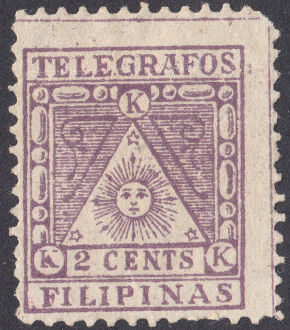 |
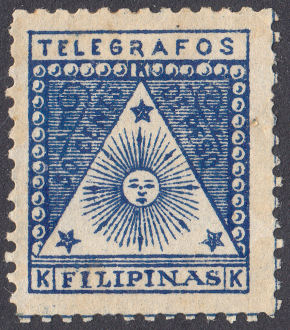 |
| Type 23, 2c. H89 | Type 24, 50c. H90 |
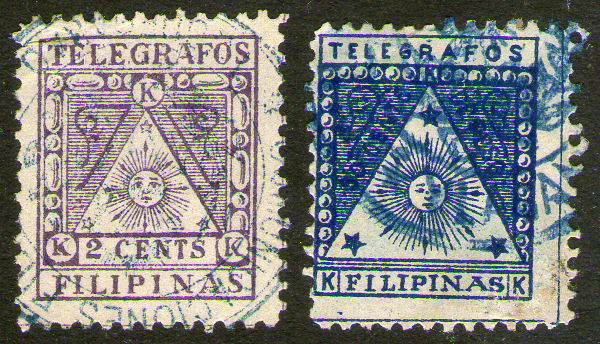
A used pair (Type I).
| Hisc. | Type. | Description | Mint | Used |
|---|---|---|---|---|
| H89 | 23 | 2c violet (shades to lilac) (Type I) | 2.50 | 6.00 |
| H89a | Type II | - | - | |
| H90 | 21 | 50c blue (Type I) | 2.00 | 10.00 |
| H90a | Type II | - | - |
Hiscocks added the following 2 notes:
| Note 1. Background information on these stamps is given in the introduction to this section. |
| Note 2. The two types of each of the above were reported by Morley in his Journal in 1902. The differences in Type II noted (relative to Type I, thought to be earlier in each case) were:- 2c Thicker paper, larger stars in the angles of the triangle, and fewer, more distinct rays to the sun. 50c Thicker paper, letters of 'PESO' to the right of the triangle malformed — tail missing on 'P' making it a small 'D', 'E' broken such as to resemble an 'F' and 'S' reversed. |
My notes: Hiscocks pricing suggests that the two types are equally scarce.
Until recently, I had only ever seen Type I, but now I have seen Type II.
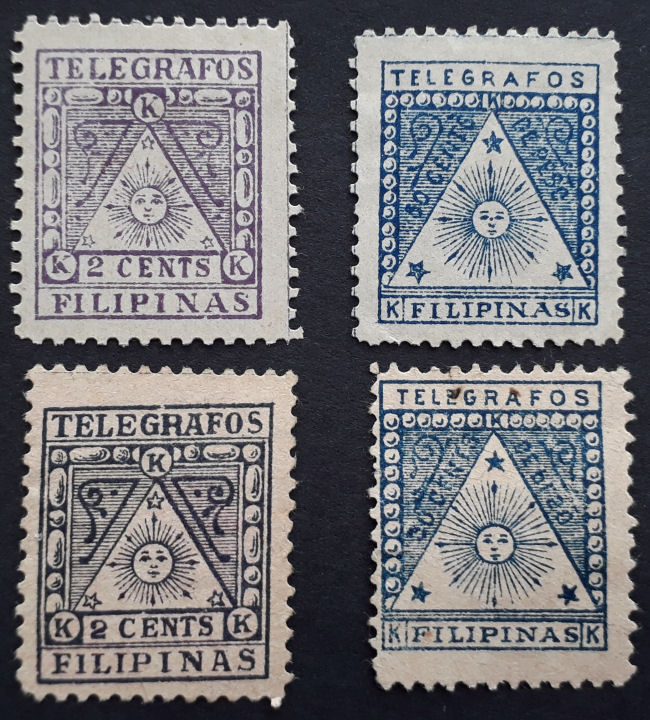
Types I (top) and II (bottom) compared courtesy of Marco Peña Cox.
The 'KKK' appearing on these stamps is an abbreviation for "Kataas-taasang, Kagalang-galang Katipunan ng mga Anak ng Bayan",
meaning "Sovereign Worshipful Association of the Sons of the Country".
Yefim Rozenshteyn has drawn my attention to a passage in the Scott catalogue that says regarding the Revolutionary stamps:
"Owing to the fact that stamps for the different purposes were not always available, together with a lack of proper instructions,
any of the adhesives were permitted to be used in the place of the other."
I will therefore list the ones in question on the understanding that this is for telegraphic usage.
As always, it is for the collector to decide what to collect.
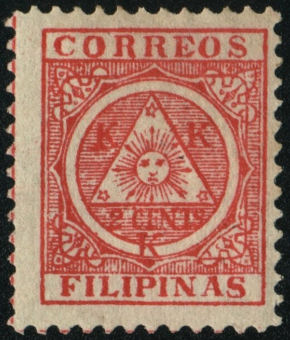 |
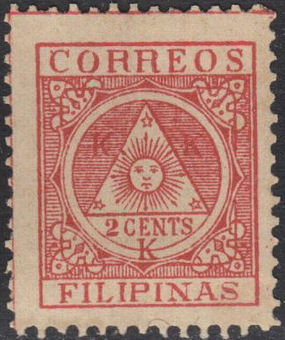 |
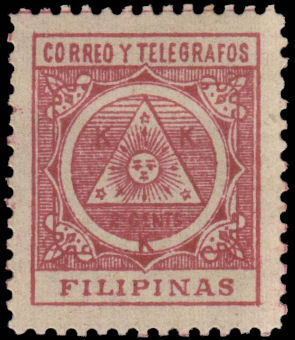 |
| 2c. HR-1 Postage | 2c. HR-2 Postage | 2c. HR-3 Posts & Telegraphs |
| Courtesy of Nigel Gooding. | Substitute telegraph stamps, courtesy of Yefim Rozenshteyn. | |
Inscribed '1898 1899'
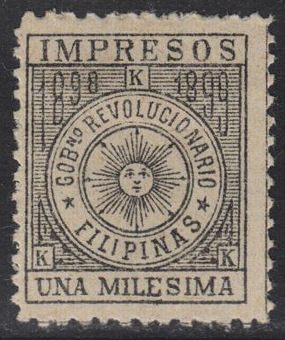 |
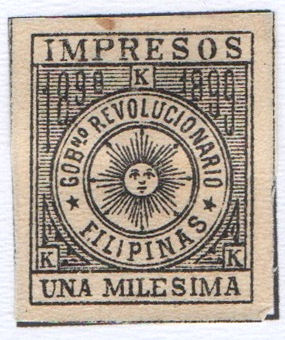 |
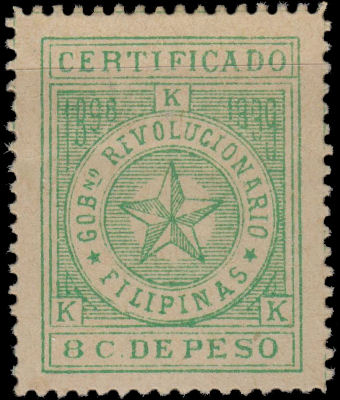 |
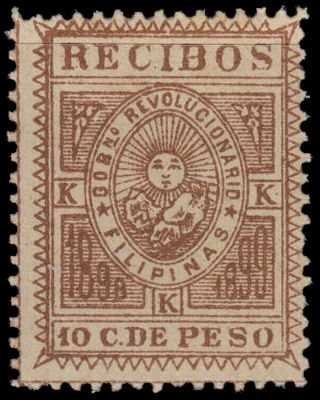 |
| 1m. HR-4 Newspaper stamp | 1m. Hr4a Newspaper stamp | 8c. HR-5 Registration stamp | 10c. HR-6 Receipt stamp |
| courtesy of Yefim Rozenshteyn. | courtesy of Les Bottomley | Substitute telegraph stamps, courtesy of Yefim Rozenshteyn. | |
| RH # | Hisc. | Type. | Description | Used |
|---|---|---|---|---|
| Hr1 | - | HR-1 | 2c red (1,500) | - |
| Hr2 | - | HR-2 | 2c red (50,000) | - |
| Hr3 | - | HR-3 | 2c carmine (10,000) | - |
| Hr4 | - | HR-4 | 1m black (50,000 including imperfs.) | - |
| Hr4a | - | imperf. | - | |
| Hr5 | - | HR-5 | 8c green (6,480) | - |
| Hr5a | - | imperf. (720) | - | |
| Hr6 | - | HR-6 | 10c brown | - |
My notes:
| Note 1. Type HR-3 would be valid for telegraphs anyway, but not specific to telegraphs. |
| Note 2. There were reprints of type HR-4 with a large 'A' in 'MILESIMA'. |
Some interesting items courtesy of Schuyler Rumsey Philatelic Auctions. Click images for listing.
Can anyone provide scans of telegraphically used examples of these?
Further information on these stamps can be found at Aguinaldo Issues.
From 1899, postage stamps were issued by the U.S. Administration.
Again, the only way to recognise Telegraphically used ones would be by their cancel.
Canton Isla de Negros.
According to PhilippinePhilatelist.net, the Cantonal Republic of Negros was established on the by Generals Aniceto Lacson and Juan A, Araneta,
and existed from November 27, 1898 until March 4, 1899. It issued crudely perforated stamps on red-brown paper with denominations of 2c, 8c, 16c, 20c and 50c.
They illustrate three of them and go on to reference "A similar stamp without denomination plus the added name
of the government department in which used was issued."
They are all inscribed "LOCALES / Telegrafos y Rentas / CORREOS" implying that they could be used for Telegraphs, Revenue or Postage.
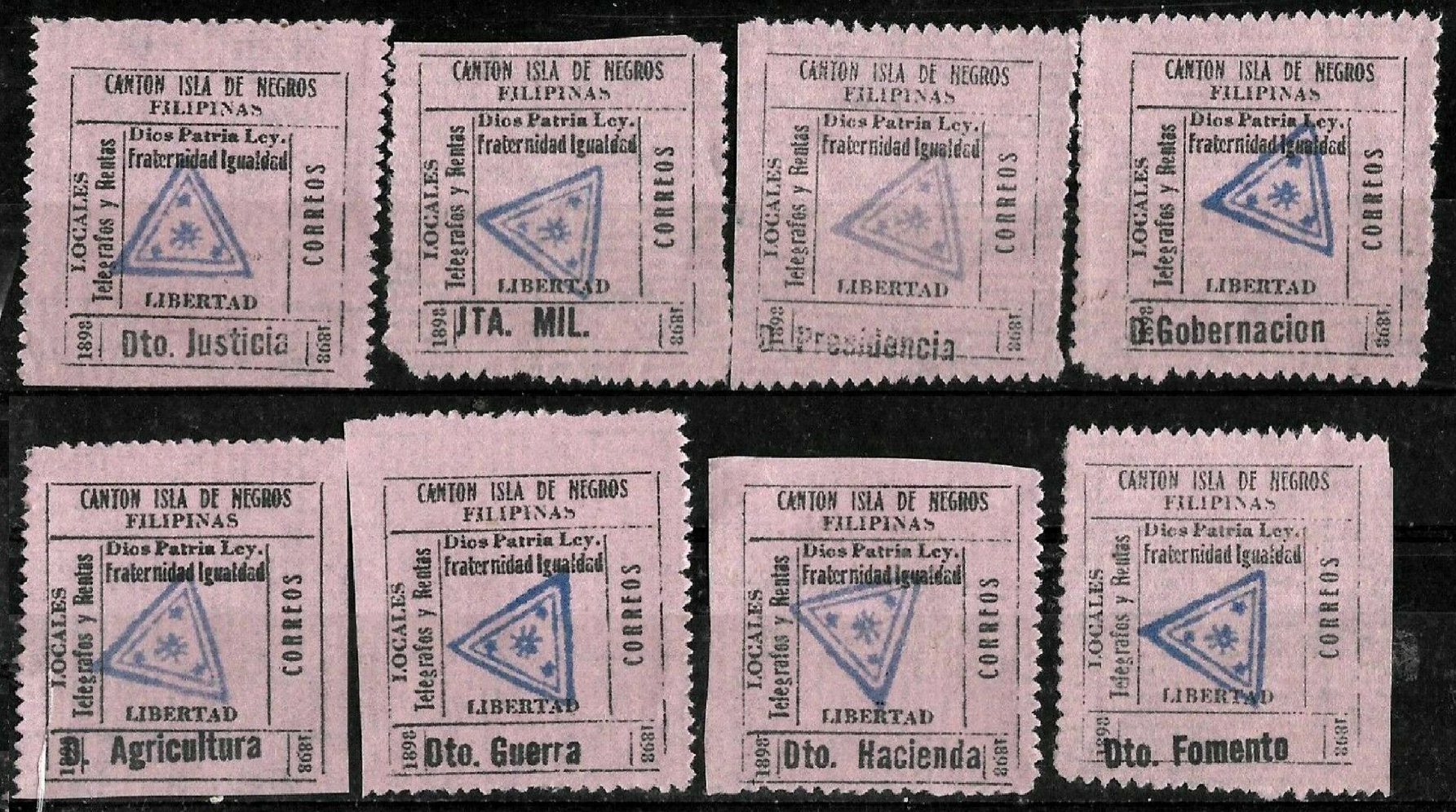
These examples are courtesy of Jeff Turnbull. There may well be other Departments that issued stamps.
According to this article on Philippine Postage Stamps, there was a further three denominations issued December, 1899, a 5c green, a 10c red, and a 20c blue.
A worrying factor though is the involvement that it mentions of a Mr. Jose E. Marco of Bacolod. If this is the same Jose E. Marco as the
'infamous antiquarian from the island of Negros' mentioned by Maureen Cristin S. Justiniano in this PDF document, then authenticity has to be questioned.
Some imperforate examples.
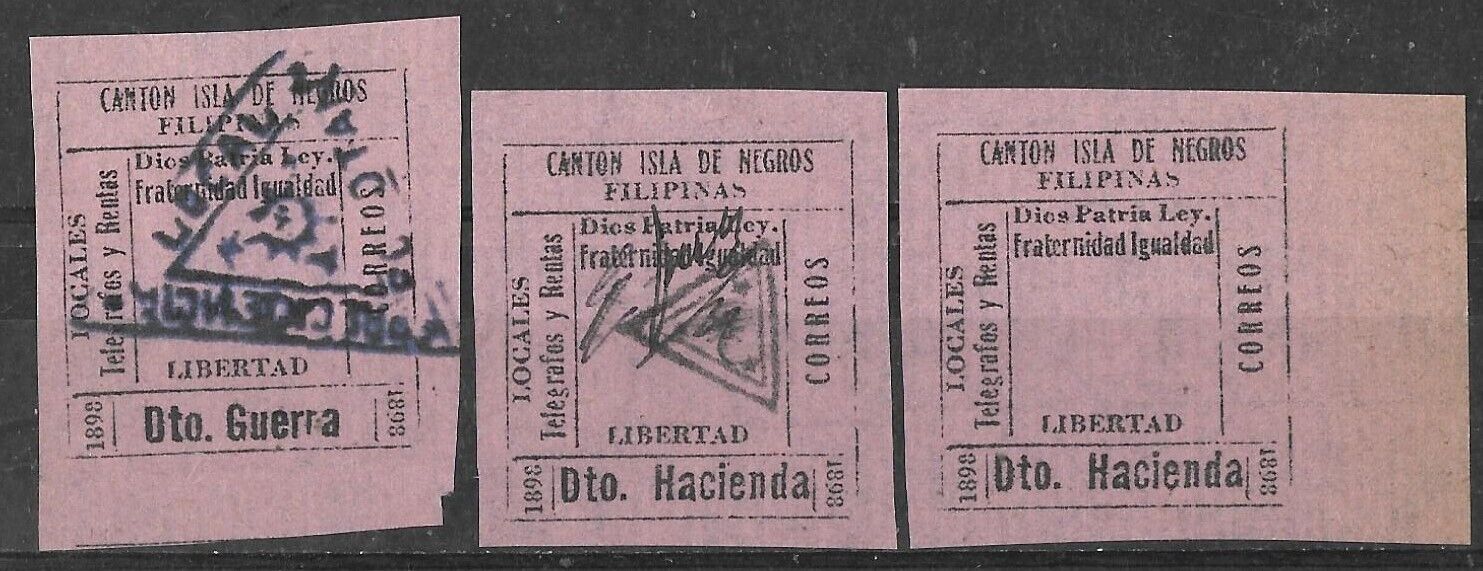
These were sold on eBay described as forgeries. Images courtesy of steno1950 on eBay (click image for listing).
Can anyone provide more scans of Isla de Negros stamps?
Usage.
Before telegraph stamps were available, postage stamps were used for telegraphic purposes.
Even after telegraph stamps were available, for whatever reason, postage stamps were often still used for telegraphic purposes.
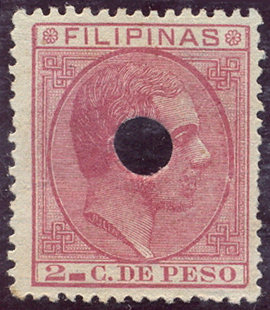
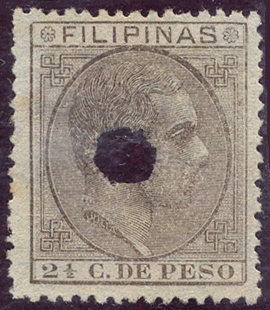
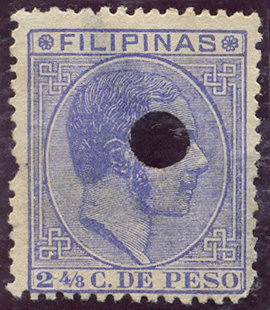
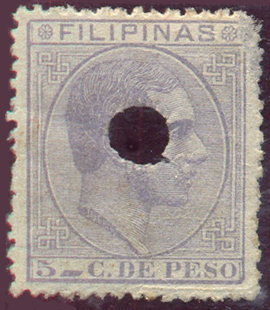
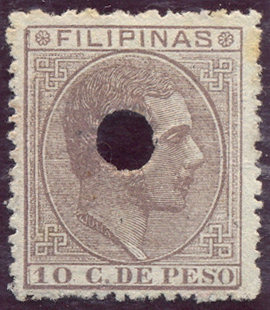
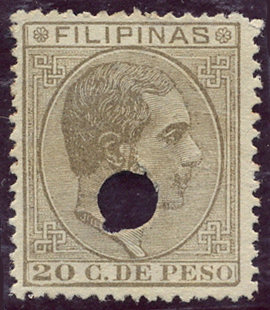
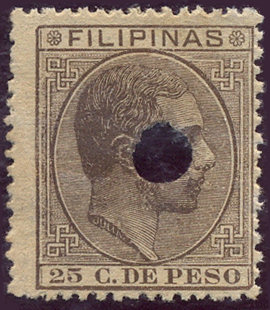
Images courtesy of Rolf Lamprecht.
The documents below show that even telegraph stamps converted to postal use could still get used telegraphically.
I have seen a number of examples of forms like this offered for sale. (front and back at 75dpi. Manila, dated 8 April 1881)
I bought this for the 2 Reales stamp at the top. The form is still intact, I digitally reconstructed the perforations for my H9 illustration.
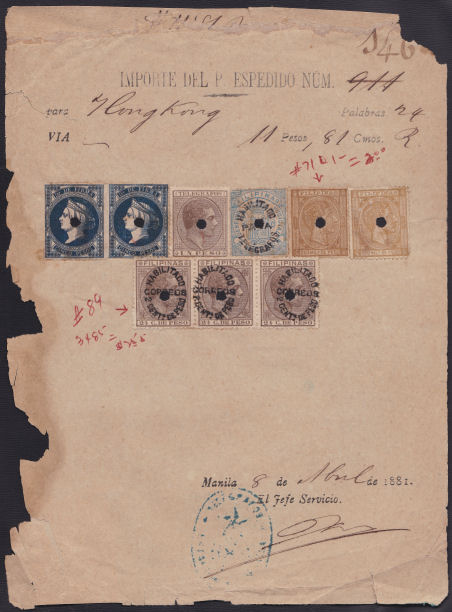
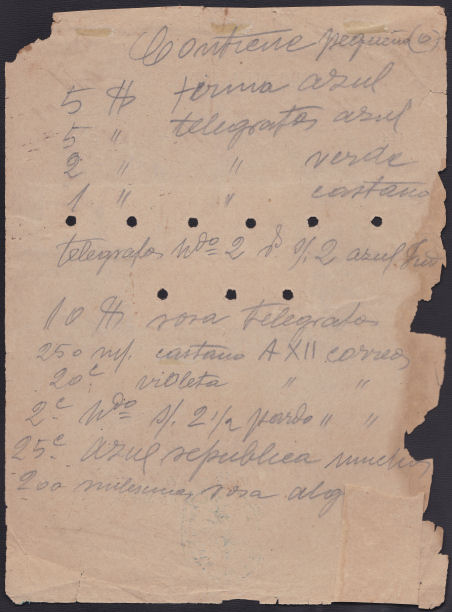
At the top, rather than a word like Telégrafos or Telegrama, it has 'Importe Del P. Espedido Núm. or 'Amount of P. Required No.'
I don't know what the 'P.' stands for though perhaps Pago for Payment, or exactly what this form is, though it clearly has something to do with telegraphy
since it says 24 words at the top (11 Pesos 81 Cmos), and has a handstamp at the bottom with 'TELEGRAFOS' around the top.
It may be a receipt for sending a telegram to Hong Kong, but I would have expected to see the word 'Recibo' on it somewhere.
The back appears to have a (rather confused) description of the stamps, though I don't see the green or violet ones listed.
The back was in pencil, but on the front someone has happily used red ballpoint to note a few catalogue numbers !
Assuming this to be telegraphic usage, how was the 11 Pesos 81 Centimos made up?
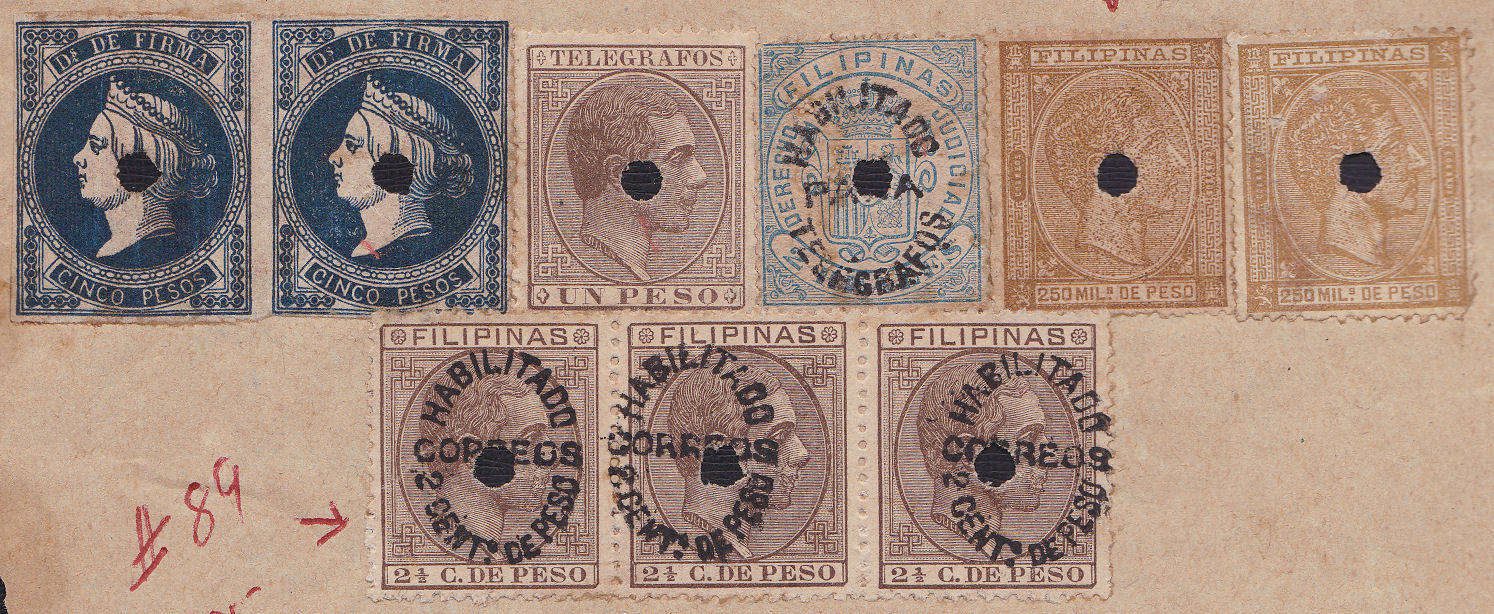
For the 11 Pesos, two 5p Derechos de Firma (1865, Forbin 4) plus a 1p (H5) Telegraph stamp were used. The 81c is made up from H9 (25c), two 250mil (25c) postage stamps,
and three 2c on 2½c postage stamps. All have been punch-cancelled. Clearly little attention was given to the intended purpose of the stamps used.
One wonders why so much trouble was taken to overprint stamps for a change of purpose.
Here is another, from Manila to Hong Kong, 13 November 1884
This was for 6 words, costing 2 Pesos 99c and paid all in postage stamps. The stamps were punched as well as being cancelled with YTC (Ynternational Telegraph Company, see note 5 below H22) above
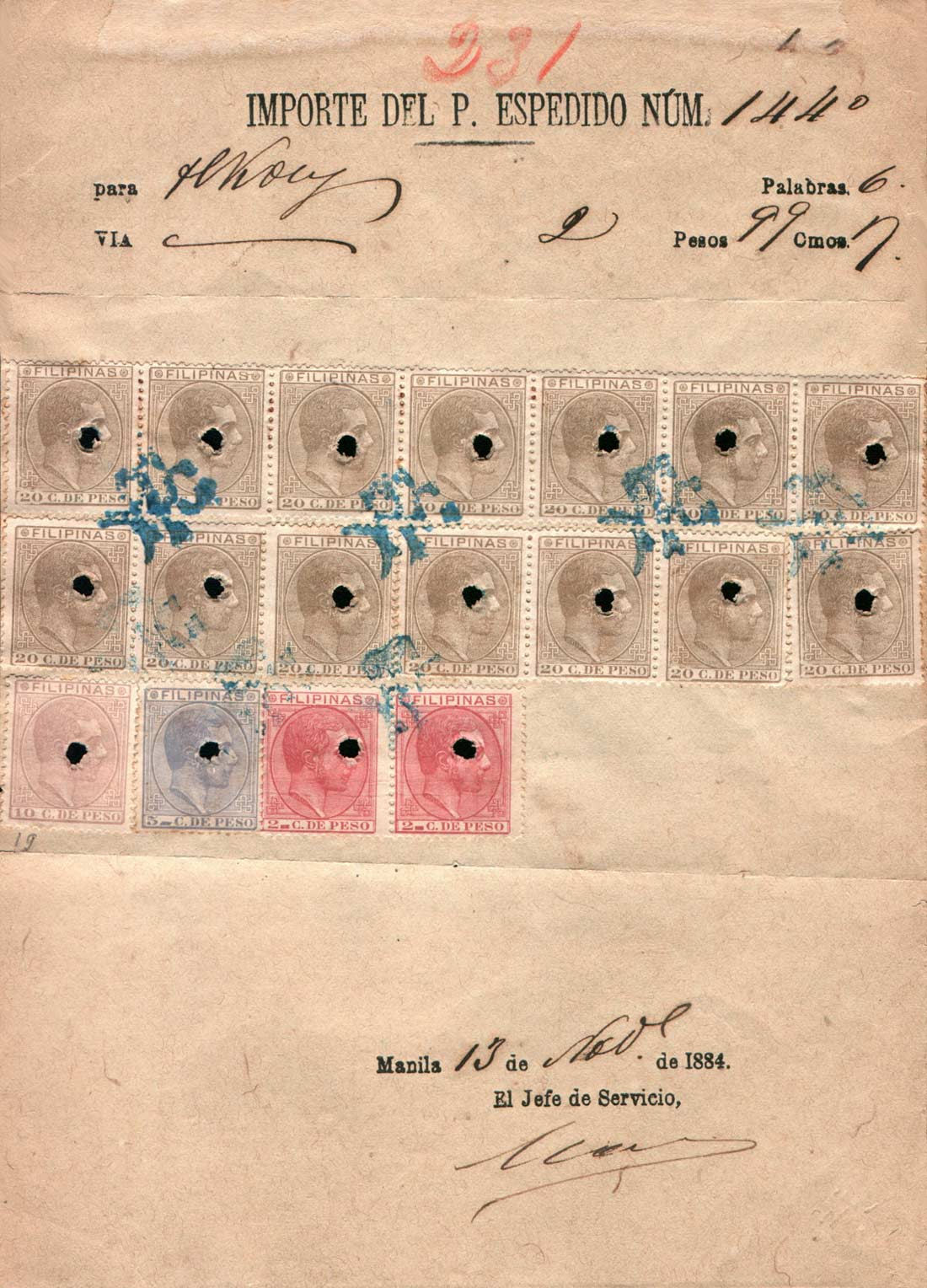
Image courtesy of Bill Glover at Atlantic-Cable.com
Here is another, similar example from Manila to Melbourne, Australia, May 1883
Perhaps a little strangely, this was sent via Suez. Certainly it had to go through Singapore, but I'm not sure what the advantage was to go to Suez and back from there.
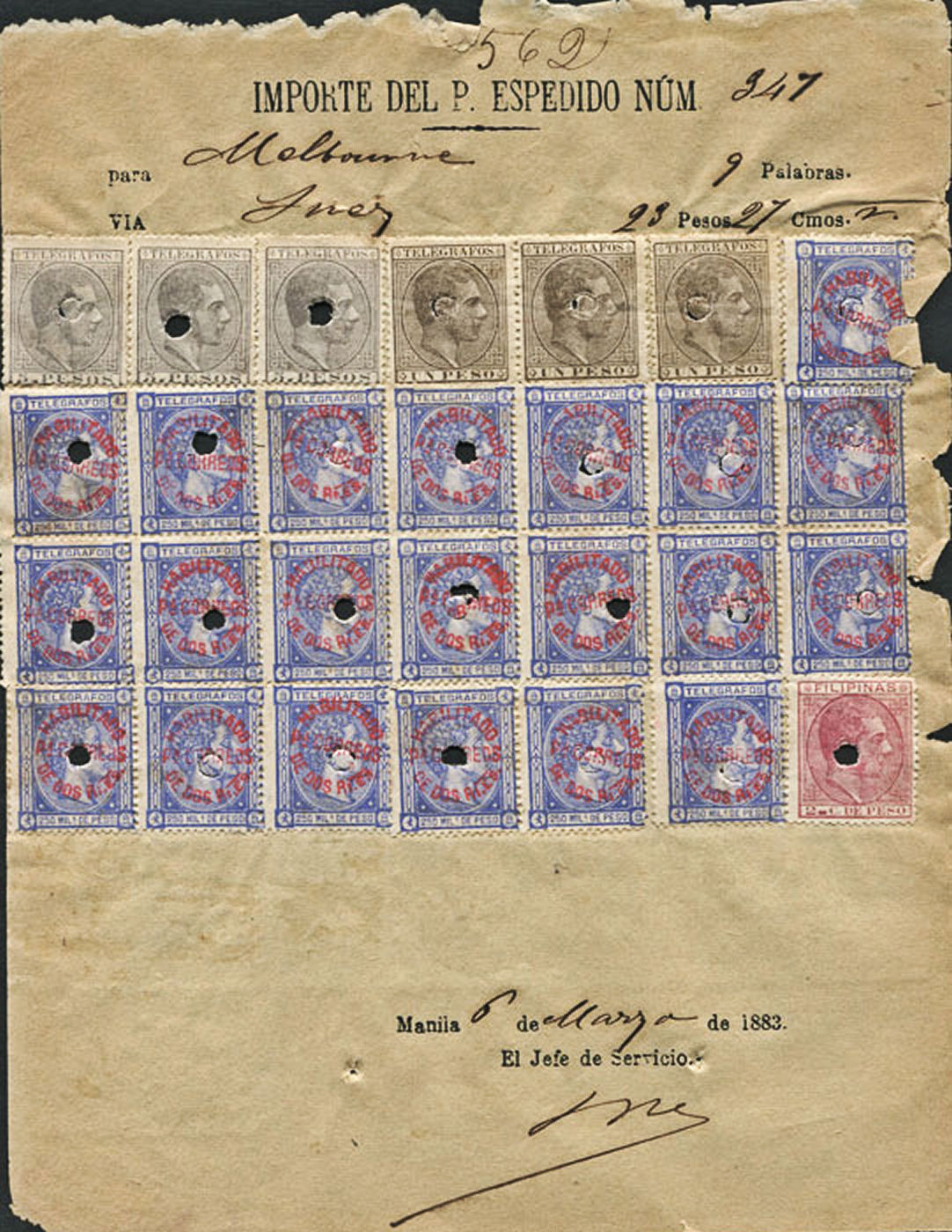
This was for 9 words, costing 23 Pesos 27c and paid for with 18P in telegraph stamps and 2c and 42 reales in postage stamps (1p = 8 reales).
The 5P stamps, H7, are a much lighter grey than my example above.
Image courtesy of David Druit of pennymead.com (click image for listing).
If anyone can provide scans to help with this page, I am happy to give appropriate credit.

